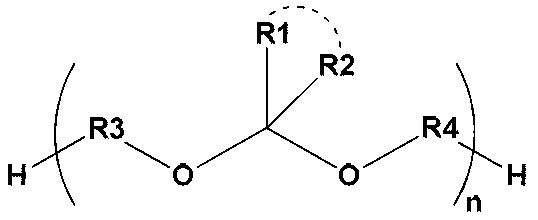Degradable mixed polyamine epoxy resin curing agent, and preparation and composite material recovery thereof
A technology of epoxy resin curing and curing agent, which is applied in the direction of plastic recycling, chemical recycling, recycling technology, etc., and can solve the problems of inability to re-melt, difficult post-processing, and low operating safety
- Summary
- Abstract
- Description
- Claims
- Application Information
AI Technical Summary
Problems solved by technology
Method used
Image
Examples
Embodiment 1
[0122] Embodiment 1: the synthesis of two (2-chloroethoxy) methane
[0123] 346 grams of toluene and 800 grams of 2-chloroethanol were successively put into the reaction flask, and 164 grams of paraformaldehyde and 4.8 grams of p-toluenesulfonic acid were put into the reaction flask while stirring, the temperature of the system was raised slowly, and the Dean-Stark refluxed to separate the water. When no water droplets were separated, the reaction was extended for another 1 hour, which was the end of the reaction. After the reaction, lower the temperature to below 40°C, add an appropriate amount of sodium carbonate to the reaction bottle, adjust the pH value of the reaction liquid system to be close to neutral, then concentrate the reaction liquid under reduced pressure, recover all the toluene, vacuum distill the residue, and collect 60-75 °C / 200pa, about 753 grams of bis(2-chloroethoxy)methane was obtained, and the yield was 87.6%.
Embodiment 2
[0124] Embodiment 2: the synthesis of two (2-chloroethoxy) methane
[0125] 346 grams of toluene and 800 grams of 2-chloroethanol were successively put into the reaction flask, and 164 grams of paraformaldehyde and 4.8 grams of p-toluenesulfonic acid were put into the reaction flask while stirring, and the temperature of the system was raised slowly, and the Dean-Stark refluxed to separate the water. When no water droplets were separated, the reaction was extended for another 1 hour, which was the end of the reaction. After the reaction, lower the temperature to below 40°C, add an appropriate amount of sodium carbonate to the reaction bottle, adjust the pH value of the reaction liquid system to be close to neutral, then concentrate the reaction liquid under reduced pressure, recover all the toluene, vacuum distill the residue, and collect 60-75 °C / 200pa, about 733 grams of bis(2-chloroethoxy)methane was obtained, and the yield was 85.3%.
Embodiment 3
[0126] Embodiment 3: the synthesis of curing agent 1
[0127] Put 960 grams of concentrated ammonia water and 150 grams of ammonium chloride into the autoclave, stir and dissolve, then add 5 grams of bis(2-chloroethoxy)methane prepared in Example 1 at 150°C, and then heat up to 180°C , stirred and reacted for 2 hours, and TLC detected the end point of the reaction. After the reaction was completed, most of the solution was concentrated under reduced pressure, and the residual solution was transferred to a reaction bottle. 300 ml of mixed solvent of chloroform and ethanol (volume ratio 3:1), extract the aqueous phase 3 times, combine the organic phase, dry the organic phase with anhydrous sodium sulfate, filter, wash the filter cake once with a small amount of solvent, and concentrate the filtrate to Dry to obtain about 3 grams of curing agent I, and its total amine value is 14.9 mmol / g (mmol / g).
PUM
| Property | Measurement | Unit |
|---|---|---|
| Total amine value | aaaaa | aaaaa |
| Total amine value | aaaaa | aaaaa |
| Total amine value | aaaaa | aaaaa |
Abstract
Description
Claims
Application Information
 Login to View More
Login to View More - R&D
- Intellectual Property
- Life Sciences
- Materials
- Tech Scout
- Unparalleled Data Quality
- Higher Quality Content
- 60% Fewer Hallucinations
Browse by: Latest US Patents, China's latest patents, Technical Efficacy Thesaurus, Application Domain, Technology Topic, Popular Technical Reports.
© 2025 PatSnap. All rights reserved.Legal|Privacy policy|Modern Slavery Act Transparency Statement|Sitemap|About US| Contact US: help@patsnap.com



